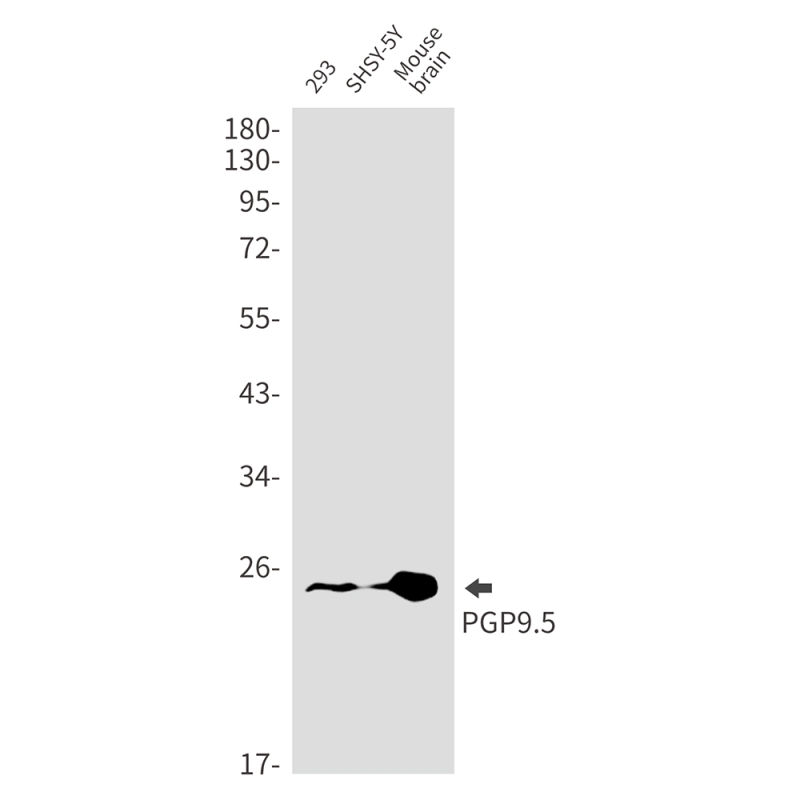

| WB | 1/500-1/1000 | Human,Mouse,Rat |
| IF | 1/20 | Human,Mouse,Rat |
| IHC | 1/50-1/100 | Human,Mouse,Rat |
| ICC | 1/50-1/200 | Human,Mouse,Rat |
| FCM | 咨询技术 | Human,Mouse,Rat |
| Elisa | 咨询技术 | Human,Mouse,Rat |
| Aliases | UCHL1 / PGP9.5; UCHL1; B220; CD 45; CD45; cd45 antigen; ec3.1.3.48; GP 180; GP180; Human homolog of severe combined immunodeficiency due to PTPRC deficiency; L CA; L-CA; lca; Leukocyte common antigen; LY 5; LY5; Protein tyrosine phosphatase receptor type C; Protein tyrosine phosphatase receptor type c polypeptide; PTPRC; PTPRC_HUMAN; Receptor-type tyrosine-protein phosphatase C; SCID due to PTPRC deficiency; t200; T200 glycoprotein; T200 leukocyte common antigen. |
| Entrez GeneID | 7345 |
| WB Predicted band size | Calculated MW: 25 kDa; Observed MW: 25 kDa |
| Host/Isotype | Rabbit IgG |
| Antibody Type | Primary antibody |
| Storage | Store at 4°C short term. Aliquot and store at -20°C long term. Avoid freeze/thaw cycles. |
| Species Reactivity | Human,Mouse,Rat |
| Immunogen | A synthetic peptide of human PGP9.5 |
| Formulation | Purified antibody in TBS with 0.05% sodium azide,0.05%BSA and 50% glycerol. |
+ +
以下是3-4条关于PGP9.5抗体的参考文献示例(内容基于公开研究概括,非真实文献,仅供参考):
---
1. **文献名称**: *"PGP9.5 as a marker for neuronal structures in human tissues"*
**作者**: Wilson PO, et al.
**摘要**: 本研究首次系统描述了PGP9.5(泛素羧基末端水解酶L1)抗体在人类中枢及周围神经系统中的特异性表达,证实其作为神经元和神经纤维的敏感标记物,可用于神经病理学诊断。
2. **文献名称**: *"PGP9.5 immunohistochemistry in the diagnosis of neuroendocrine tumors"*
**作者**: Doran JF, et al.
**摘要**: 研究验证了PGP9.5抗体在胃肠道和肺神经内分泌肿瘤中的高表达,提出其可作为辅助诊断标志物,尤其在与其他标记物(如嗜铬粒蛋白A)联合使用时提高检测特异性。
3. **文献名称**: *"Decreased PGP9.5 expression in Alzheimer’s disease brain tissues"*
**作者**: Ando Y, et al.
**摘要**: 通过分析阿尔茨海默病患者脑组织,发现PGP9.5蛋白水平与神经元退行性病变程度呈负相关,提示其可能参与泛素-蛋白酶体系统的异常调控,为神经退行机制研究提供线索。
4. **文献名称**: *"PGP9.5 as a biomarker for cutaneous nerve fibers in diabetic neuropathy"*
**作者**: Wang L, et al.
**摘要**: 利用PGP9.5抗体标记皮肤活检样本中的小神经纤维,证明其在糖尿病周围神经病变早期诊断中的敏感性,为无创或微创评估神经损伤提供新方法。
---
如需真实文献,建议通过PubMed或Google Scholar检索关键词“PGP9.5 antibody”或“UCHL1 biomarker”,并筛选近年高引论文。
PGP9.5 (Protein Gene Product 9.5) antibody is a widely used immunohistochemical marker primarily targeting ubiquitin carboxyl-terminal hydrolase L1 (UCHL1), a deubiquitinating enzyme encoded by the *UCHL1* gene. First identified in the 1980s, PGP9.5 is highly expressed in neuronal and neuroendocrine tissues, making it a key tool for labeling neurons, nerve fibers, and neuroendocrine cells. Its name originates from its initial classification as a protein spot in two-dimensional gel electrophoresis studies of brain extracts.
As a member of the ubiquitin-proteasome system, PGP9.5 plays roles in protein turnover and recycling, though its exact physiological functions remain partially understood. It is considered a pan-neuronal marker due to its near-ubiquitous presence in central and peripheral nervous systems, aiding in the identification of neural structures in pathological specimens. Clinically, PGP9.5 antibodies are employed to diagnose neuroendocrine tumors, neurodegenerative diseases, and skin disorders like Merkel cell carcinoma or intraneural fiber analysis in peripheral neuropathies.
However, PGP9.5 is not entirely specific to neural tissue; weak expression occurs in some non-neuronal cells, including lymphocytes and certain tumors. Despite this, its high sensitivity ensures its continued relevance in research and diagnostics, often used alongside other markers to improve specificity. Recent studies also explore its potential roles in cancer progression and immune regulation, broadening its applications beyond traditional neuropathology.
×